We left off with our last article on the Raptor upgrade story with putting a new set of upgraded turbos on our truck to get even more performance than the +140hp tune that we made was able to provide us with. Our raptor was sitting at 538hp the last time we talked about it. Now that we have the upgraded to 46mm turbos on the Raptor we need to tune the truck again and see if there are any other limiting factors when it comes to our goal of making the 610hp to beat the TRX. After a new tune was written for new turbos the truck was put back on the dyno and we were able to make the just over 550 horsepower before the engine was automatically throttled back by the ECM trying to combat the rising intake air temps. This tells us that the truck, while capable of more power, still needs improvements before it will be able to perform as well as the TRX for a sustained amount of time. Below is a graph showing the intake air temp during a road pull in the raptor. The Orange line represents Intake air temp and you can see it spike under sustained load up until the throttle is let off.

Here's what we had on the truck before we started testing:
- Upgraded 46mm turbos
- Fuel Injector Clinic 1000cc injectors.
- Custom Tune By Calibrated Power Solutions

These higher than normal intake air temperatures are no surprise on turbo-charged vehicles due to the air being compressed. This holds the same amount of heat energy in a more confined space which causes compressed volumes to be hotter. Because of this most turbo-charged gas engines use an intercooler to control the intake air temperature. This is the same in the case of the Raptor. Since the Raptor already has a stock intercooler and the only thing we’ve changed in the design is the amount of air traveling through it per minute. We know the stock unit has reached its volumetric cooling limit. This means it will need to be the next part that we upgrade in order to access the horsepower we’re looking for.
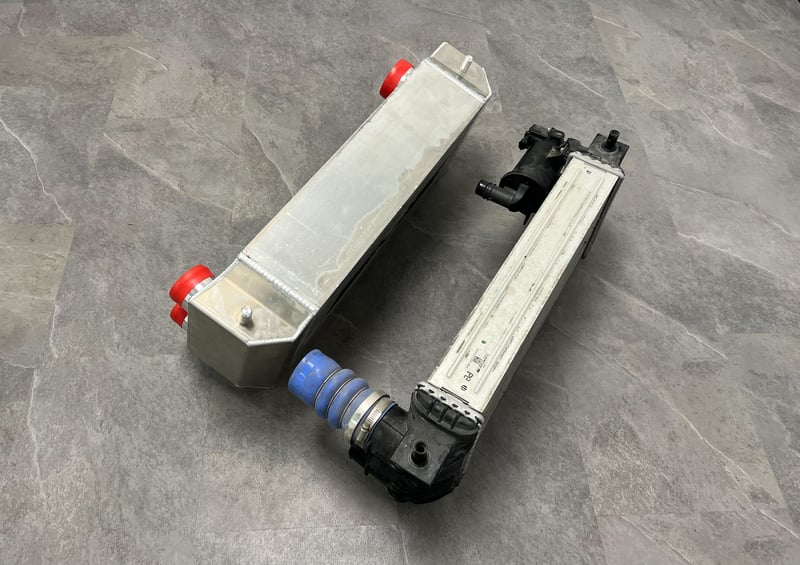
If we look at the stock intercooler on the raptor we can easily see how its design could be improved. The raptor sports a small and inefficient single intercooler in the front bumper. To make things worse the intake that feeds it is often obstructed by the license plate mounting being right in front of the opening. Aftermarket intercoolers provide 2 different solutions that both offer advantages and disadvantages. The option that offers the highest performance in terms of power are full front mount intercoolers. Which disregard the factory mounting position in favor of moving the intercooler to the main grill area. This provides more space for a much larger intercooler along with more grill area to intake air from. However, this option creates the distinct disadvantage of having to cool your radiator with air that’s already had heat put into it from the intercooler. Making your long-term performance suffer.

For our build, we chose to go with an AMS intercooler that retains the factory mounting location and air ducting. All while being more than double the size of stock. 5.5 in thick compared to the stock 2.5in intercooler. This option also has the advantage of using the stock ducting which means extra fabrication and relocation of the blow-off valve is not necessary. We also calculated that we need to get the intake air temps down by about 25deg to keep us from getting into the thermal throttling of the ECM. So this solution will be more than we need to keep our intake air temps down.

In addition to upgrading the intercooler, we also decided it would be extremely worthwhile to upgrade the stock intake boost tubes as well. We have found that restrictive intake designs like the one found on the Raptor create a sufficient restriction that decreases turbo efficiency and ultimately makes the turbo's work harder. On top of that restrictive flow can also be a contributor to higher intake air temps due to the air being compressed. If you look at the intake boost tubes on the Raptor you can see lots of restrictions. The AMS intake tubes we went with noticeably improve the restrictive design. Hopefully, this improvement will provide us with just a bit better turbo efficiency which we can turn into added Horsepower through tuning. Along with better conditions for keeping the intake air temps down blow the threshold of throttling through the ECM.
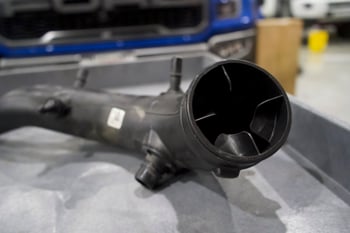
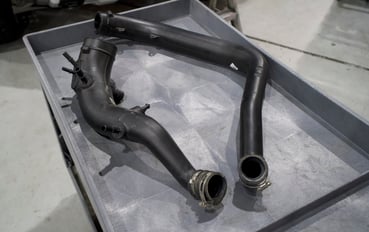
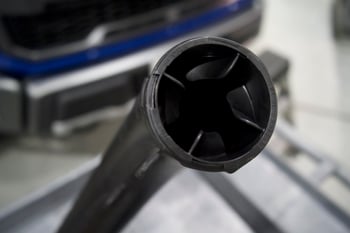
- Stock Raptor Intake Boost Tube Restrictions
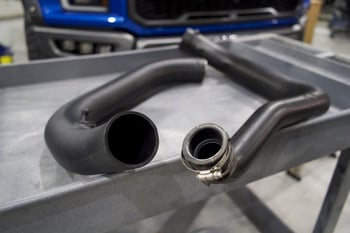
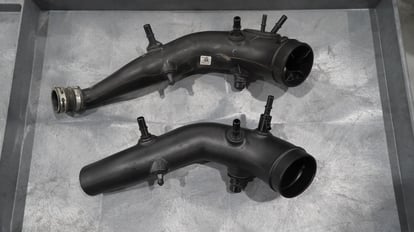
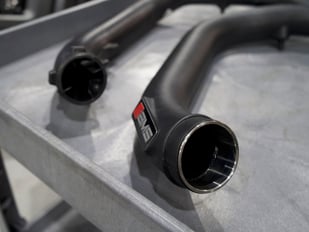
- Comparison of New to Old Intake Boost Tubes
After getting the intake and intercooler on we went right to tuning the truck to see what we could make with the new parts installed. After a few runs on the dyno and some real-world data logging. The truck put down the most we've seen at 588 rear-wheel horsepower before we saw the fuel rail pressure start dropping. This means we've run into yet another barrier on our way to the 610hp we think it will take to beat the TRX. However If you look at the graph below, it (the orange line) shows the intake air temperatures of the raptor with the intercooler installed you can see the the problem of excessive intake air temps has been remedied thanks to our new intercooler and intake tubes. Along with that drivability wise, there's a very minimal difference in spool up with the after market turbos. The topic of keeping the raptor fueled will be covered in the next Diesel Tuner Blog post. So stay subscribed to keep posted on the next upgrade in our saga to get the Raptor up to TRX specs.

Check out other articles in this series here:




